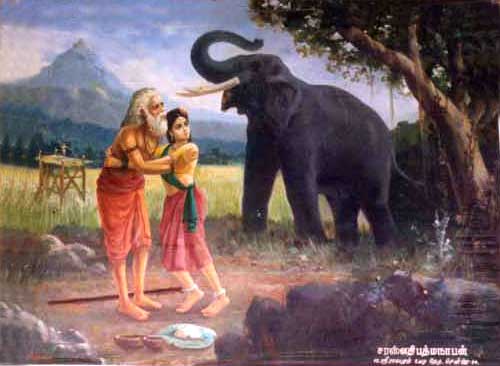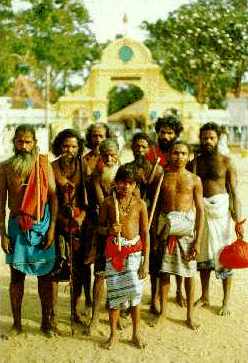 
Proposed Eco-Cultural Sanctuary at Kataragama
![[Cultural Survival of Sri Lanka logo]](../pix/cscolor.gif) At
Ulpotha near Embogama in Kurunegala district Cultural Survival of Sri Lanka has created Sri Lanka's sole authentic Eco-Cultural Sanctuary, a working puranagama (ancient hamlet) where holistic principles are an integral part of everyday life. Ulpotha
Sanctuary, Sri Lanka, is an olagama, a puranagama
whose traditional infrastructure (devale temple & irrigation system)
has been restored entirely through private sector funding on a modest scale.
Anyone may come and see for him- or herself the extent of Cultural Survival's
remarkable success in terms of facilitating sustainable ecological development
to promote the welfare of Sri Lankan villagers, the real custodians of
Sri Lanka's cultural and environmental heritage.

|
At that moment, Murugan invoked the help of his brother Vināyaka who appeared behind Valli in the shape of a frightening elephant. The terror-stricken girl rushed into the arms of the Saiva ascetic for protection. Painting from Tiruttani Devasthanam. |
Kataragama Sanctuary
In the far Southeast of Sri Lanka at the Sacred City of Kataragama,
settlers from various communities are encroaching upon a sizable extent
of Yala National Park near the Kataragama Mahadevale. Without any traditional
organization or livelihood, they depend on environmentally-destructive
activities like illicit gemming and tree-felling. But clearly the piecemeal
destruction of Deviyange Kæle (the God's own Forest) and desecration
of the sacred Menik Ganga are neither in the interest of Sri Lanka nor
in the long-term interest of the settlers themselves. Indeed, their sorry
plight is symptomatic of a larger process that threatens to destroy what
remains of Kataragama's and the Sri Lanka's once-proud eco-cultural heritage.
This is where the Eco-Cultural
Sanctuary concept makes perfect sense for implementation in Kataragama
as a model showcase of the tremendous potential of the South for culturally-appropriate
environmentally- sustainable development. Cultural Survival is ready to
design the concept and demonstrate how a sustainable devale-based
culture can survive and prosper for centuries to come. Cultural Survival
would call the sanctuary Deyangegama, 'the God's own village'.
Features of a proposed Eco-Cultural Sanctuary at Kataragama:

|
|
Wanniya-laeto at Kataragama
|
Declaring the sacred left bank of the Menik Ganga at Kataragama to be an
Eco-Cultural Sanctuary involves a gradual restoration of traditional values
and lifestyles long associated with traditional rural life in Sri Lanka.
Each of Sri Lanka's Sacred Cities encapsules aspects of the island nation's
cultural and spiritual inheritance -- and Kataragama exceptionally well-endowed
with ancient wisdom traditions that are as alive today as they were thousands
of years ago when the Wanniya-laeto ('inhabitants of the Wanni forest) and yakshas (arboreal spirits) alone knew the marvels of island
Lanka.
These same ancient traditions find natural application in the sylvan
setting of Kataragama, the home of Sri Lanka's hands-down favorite divinity,
angel, bodhisattva, prophet -- for Sri Lankan Buddhists, Hindus, and Muslims
(in that numerical order) all come to Kataragama to pay their respects
to the friendly Power who graces Kataragama or Kathir-kamam.
These long-standing and still widely-recognized traditional guidelines
to wholesome, healthy and happy life would assume forms appropriate to
the sacred setting of Kataragama and the changing face of life in Sri Lanka
and anywhere in the global village. Some proposed features of an Eco-Cultural
Sanctuary at Kataragama could include: 
-
Traditional laws & practices to take precedence over statutory laws;
-
Showcase of cultural diversity: Sinhala, Tamil & Muslim live together
while preserving their distinct identities paramparas;
-
Traditional wattle-and-daub style community centres to coordinate &
implement local development strategies;
-
Promotion of private investment in pilgrimage-related local cottage industries
such as rosaries, vibhuti, and other pilgrims' accessories;
-
Eco-tourism: eco-friendly traditional accomodation & meals and accommodation
for traditional pilgrims wanting to experience the spirituality of Kataragama
in a forest setting;
-
Encourage local and foreign visitors wishing to engage in traditional studies
to learn traditional arts including cooking and agriculture ;
-
Niche marketing of organically-grown garden produce, home-made and home-designed
handicrafts;
-
Promotion of indigenous health and nutrition practices, protection and
judicious use of medicinal forests;
-
Certain restrictions on motor traffic within the Sanctuary Zone;
-
Protected zone of the Menik Ganga subject to progressive ban on gemming
and rock quarrying;
-
Progressive ban on electronic sound amplification to in the cultural sanctuary;
-
Non-violent conflict resolution through traditional practices like asana
deka bana;
-
Restrictions on culturally-inappropriate commercial activities (e.g. lottery
marketing;
-
Moratorium on construction of non-traditional (especially cement, I.e.
permanent) buildings;
-
Bank credit for families wishing to construct traditional-style dwellings
or start up traditional cottage industries based in the Eco- Cultural Sanctuary;
-
Fair compensation for families who preserve traditions of performing Rajakariya
service;
-
Manufacture of pilgrims' bag & clothing items for sale to pilgrims
eliminates question of how to market items to people from all corners of
Sri Lanka;
-
Occupational training for village youth in traditional principles of environmental
stewardship;
-
Authentic Kataragama-made organic incense manufactory;
-
Appropriate marketing strategies for locally-made rosaries, lithographic
prints, devotional booklets, etc. including handicraft cooperative.
-
Sale of buffalo curd & traditional goods at kiosks in Kataragama town;
-
Tutoring foreign students in aspects of Sri Lankan culture, language, lifestyle,
cooking, folklore, etc.;
-
Promotion of technology transfer through introduction of user-friendly
(ie Sinhala and Tamil character-based display) multi-media computer technology;
-
Train village youth in traditional principles of environmental stewardship
by publicly discussing the causes of environmental destruction;
-
Cleaner Menik Ganga water resources through environmental education; participation
in 'Sister Rivers' programmes that link efforts to preserve riverine environments
in different parts of the globe;
-
A Village University campus to offer degree courses in eco-theory
and practice, traditional arts and sciences (astrology, medicine, etc.)
for local & foreign students;
-
Provisions to ensure the sanctuary's integrity and continuity for generations
to come;
-
Provisions to recognize and protect indigenous intellectual property rights
legally -- especially those pertaining directly to Kataragama;
-
National and international recognition of Kataragama as a Zone of Peace;
For
more information about related activities of the Kataragama Devotees Trust
, visit these web pages:
Send your comments to the home page curator Patrick Harrigan kataragama@gmail.com
|

![[Cultural Survival of Sri Lanka logo]](../pix/cscolor.gif)

